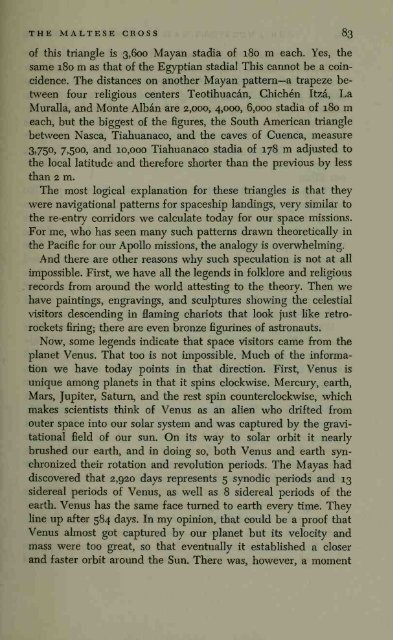You also want an ePaper? Increase the reach of your titles
YUMPU automatically turns print PDFs into web optimized ePapers that Google loves.
THE MALTESE CROSS 83<br />
of this triangle is 3,600 Mayan stadia of 180 m each. Yes, the<br />
same 180 m as that of the Egyptian stadial This cannot be a coincidence.<br />
The distances on another Mayan pattern—a trapeze between<br />
four religious centers Teotihuacan, Chichen Itza, La<br />
Muralla, and Monte Alban are 2,000, 4,000, 6,000 stadia of 180 m<br />
each, but the biggest of the figures, the South American triangle<br />
between Nasca, Tiahuanaco, and the caves of Cuenca, measure<br />
3,750, 7,500, and 10,000 Tiahuanaco stadia of 178 m adjusted to<br />
the local latitude and therefore shorter than the previous by less<br />
than 2 m.<br />
The most logical explanation for these triangles is that they<br />
were navigational patterns for spaceship landings, very similar to<br />
the re-entry corridors we calculate today for our space missions.<br />
For me, who has seen many such patterns drawn theoretically in<br />
the Pacific for our Apollo missions, the analogy is overwhelming.<br />
And there are other reasons why such speculation is<br />
not at all<br />
impossible. First, we have all the legends in folklore and religious<br />
records from around the world attesting to the theory. Then we<br />
have paintings, engravings, and sculptures showing the celestial<br />
visitors descending in flaming chariots that look just like retrorockets<br />
firing; there are even bronze figurines of astronauts.<br />
Now, some legends indicate that space visitors came from the<br />
planet Venus. That too is<br />
not impossible. Much of the information<br />
we have today points in that direction. First, Venus is<br />
unique among planets in that it spins clockwise. Mercury, earth,<br />
Mars, Jupiter, Satiun, and the rest spin counterclockwise, which<br />
makes scientists think of Venus as an alien who drifted from<br />
outer space into our solar system and was captured by the gravitational<br />
field of our sun. On its way to solar orbit it nearly<br />
brushed our earth, and in doing so, both Venus and earth synchronized<br />
their rotation and revolution periods. The Mayas had<br />
discovered that 2,920 days represents 5 synodic periods and 13<br />
sidereal periods of Venus, as well as 8 sidereal periods of the<br />
earth. Venus has the same face turned to earth every time. They<br />
line up after 584 days. In my opinion, that could be a proof that<br />
Venus almost got captured by our planet but its velocity and<br />
mass were too great, so that eventually it established a closer<br />
and faster orbit around the Sun. There was, however, a moment

















